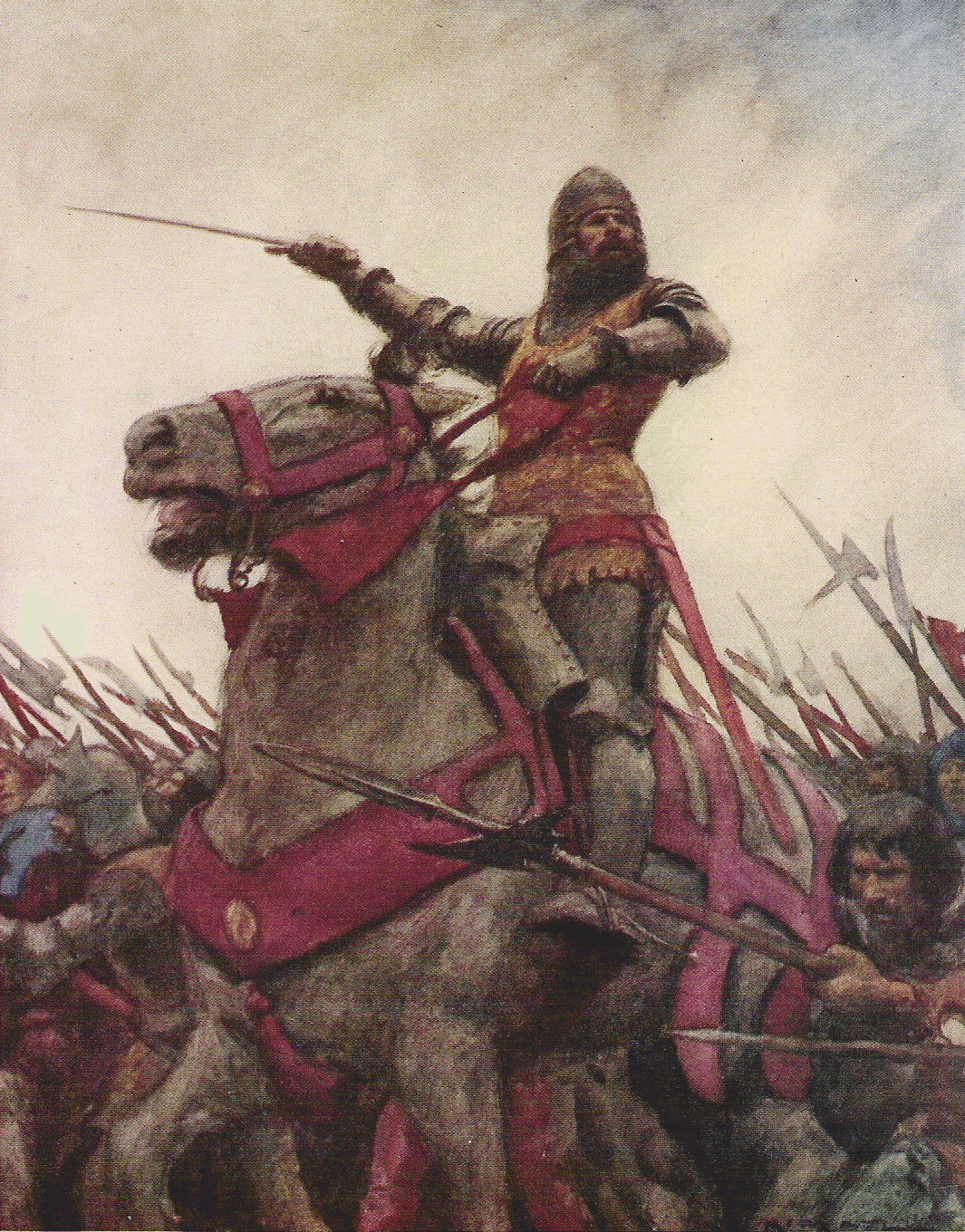|
Jean II De Rieux
Jean II de Rieux (1342 - 1417) Breton Lord of Rieux, Rochefort and Ancenis, initially in the service of Brittany, but also eventually a Marshal of France in the service of King Charles VI. He was the great-grandfather of Jean IV de Rieux. Career With the Duchy of Brittany and the Kingdom of England Jean fought under the command of the English Edward the Black Prince, participating in the Battle of Nájera (1367), against the French led by Bertrand du Guesclin. Although the English won the battle, the Black Prince went bankrupt. He was one of the signatories of the second Treaty of Guérande in 1381 as a representative for the Duke of Brittany John IV. The Duke had restored his rights and agreed to make a small tribute to the King Charles VI. Furthermore, Brittany would stay neutral in continuing military conflicts between France and England. With the Kingdom of France Jean then offered his services to France. In 1382 he fought at the Battle of Roosebeke. In 1397 De Rieux wa ... [...More Info...] [...Related Items...] OR: [Wikipedia] [Google] [Baidu] |
Battle Of Roosebeke
The Battle of Roosebeke (sometimes referred by its contemporary name as Battle of Westrozebeke) took place on 27 November 1382 on the Goudberg between a Flemish army under Philip van Artevelde and a French army under Louis II of Flanders who had called upon the help of the French king Charles VI after he had suffered a defeat during the Battle of Beverhoutsveld. The Flemish army was defeated, Philip van Artevelde was slain and his corpse was put on display. Prelude Philip the Bold had ruled the council of regents from 1380 till 1388, and ruled France during the childhood years of Charles VI, who was Philip's nephew. He deployed the French army in Westrozebeke to suppress a Flemish rebellion led by Philip van Artevelde, who intended to dispose of Louis II of Flanders. Philip II was married to Margaret of Flanders, Louis' only surviving child and heiress. Ghent Ghent had rebelled against Count Louis II of Flanders. The Count surrounded the city, and when the citizens of ... [...More Info...] [...Related Items...] OR: [Wikipedia] [Google] [Baidu] |
Marshals Of France
Marshal of France (, plural ') is a French military distinction, rather than a military rank, that is awarded to generals for exceptional achievements. The title has been awarded since 1185, though briefly abolished (1793–1804) and for a period dormant (1870–1916). It was one of the Great Officers of the Crown of France during the and Bourbon Restoration, and one of the Grand Dignitaries of the Empire during the First French Empire (when the title was Marshal of the Empire, not Marshal of France). A Marshal of France displays seven stars on each shoulder strap. A marshal also receives a baton – a blue cylinder with stars, formerly fleurs-de-lis during the monarchy and eagles during the First French Empire. The baton bears the Latin inscription of ', which means "terror in war, ornament in peace". Between the end of the 16th century and the middle of the 19th century, six Marshals of France were given the even more exalted rank of Marshal General of France: , , , , , a ... [...More Info...] [...Related Items...] OR: [Wikipedia] [Google] [Baidu] |
1417 Deaths
Year 1417 ( MCDXVII) was a common year starting on Friday of the Julian calendar. Events January–March * January 19 – After the dismissal of Al-Musta'in as Caliph of Cairo by the Sultan Shaykh al-Mahmudi is declared unlawful by Islamic clerics, Shaykh arranges Al-Musta'in and three sons of the late Sultan Faraj to be transferred away from Cairo to Alexandria. * January 19 – Joanna II, Queen of Naples, issues a pardon for Giacomo Orsini, who had rebelled against her predecessor, King Ladislaus of Naples. * February 15 – In Korea, Grand Prince Yangnyeong of the Joseon Kingdom and heir to the throne, causes a scandal that ends any possibility of becoming the next King. Yangnyeong courts the wife of another official and attempts to bring here into the royal palace in Seoul, ending in his banishment from the royal household and being replaced on June 3, 1418. * February 24 – An envoy of the Sultan of the Ottoman Empire, identified in Italian re ... [...More Info...] [...Related Items...] OR: [Wikipedia] [Google] [Baidu] |
1342 Births
Year 1342 ( MCCCXLII) was a common year starting on Tuesday and current year of the Julian calendar. Events January–December * January 21–June 27 – An-Nasir Ahmad, Sultan of Egypt, rules prior to being deposed by his half-brother As-Salih Ismail. * May 7 – Pope Clement VI succeeds Pope Benedict XII, as the 198th Pope. * July 16 – Louis I becomes king of Hungary. * July 18 – Battle of Zava: Mu'izz al-Din Husayn defeats the Sarbadars. * July 22 – St. Mary Magdalene's flood is the worst such event on record for central Europe. * August 15 – Louis "the Child", age 4, succeeds his father, Peter II, as king of Sicily and duke of Athens; he is crowned on September 15 in Palermo Cathedral. * September 4 – John III of Trebizond (John III Comnenus) becomes emperor of Trebizond. Date unknown * Guy de Lusignan becomes Constantine II, King of Armenia (Gosdantin, Կոստանդին Բ). * The Greek Orthodox patriarch of Anti ... [...More Info...] [...Related Items...] OR: [Wikipedia] [Google] [Baidu] |
Haverfordwest
Haverfordwest ( , ; ) is the county town of Pembrokeshire, Wales, and the most populous urban area in Pembrokeshire with a population of 14,596 in 2011. It is also a Community (Wales), community consisting of 12,042 people, making it the second most populous community in the county after Milford Haven. The suburbs include the former parish of Prendergast, Pembrokeshire, Prendergast, Albert Town and the residential and industrial areas of Withybush (housing, retail parks, Withybush General Hospital, hospital, Withybush Airport, airport and showground). Haverfordwest has a strategic location: it was the lowest bridging point of the Western Cleddau before the Cleddau Bridge opened in 1975. Topography Haverfordwest is a market town, the county town of Pembrokeshire and an important road network hub between Milford Haven, Pembroke Dock, Fishguard and St David's as a result of its position at the tidal limit of the River Cleddau, Western Cleddau. The majority of the town, compris ... [...More Info...] [...Related Items...] OR: [Wikipedia] [Google] [Baidu] |
Owain Glyndŵr
Owain ap Gruffydd (28 May 135420 September 1415), commonly known as Owain Glyndŵr (Glyn Dŵr, , anglicised as Owen Glendower) was a Welsh people, Welsh leader, soldier and military commander in the Wales in the late Middle Ages, late Middle Ages, who led a Glyndŵr rebellion, 15-year-long Welsh revolt with the aim of ending Kingdom of England, English rule in Wales. He was an educated lawyer, forming the first Welsh parliament under his rule, and was the last native-born Welshman to claim the title Prince of Wales. During the year 1400, Glyndŵr, a Welsh soldier and Glyndyfrdwy, Lord of Glyndyfrdwy had a dispute with a neighbouring Peerage of England, English Lord, the event which spiraled into a national revolt pitted common Welsh countrymen and nobles against the English military. In response to the rebellion, discriminatory Penal laws against the Welsh, penal laws were implemented against the Welsh people; this deepened civil unrest and significantly increased support for ... [...More Info...] [...Related Items...] OR: [Wikipedia] [Google] [Baidu] |
Siege
A siege () . is a military blockade of a city, or fortress, with the intent of conquering by attrition, or by well-prepared assault. Siege warfare (also called siegecrafts or poliorcetics) is a form of constant, low-intensity conflict characterized by one party holding a strong, static, defensive position. Consequently, an opportunity for negotiation between combatants is common, as proximity and fluctuating advantage can encourage diplomacy. A siege occurs when an attacker encounters a city or fortress that cannot be easily taken by a quick assault, and which refuses to surrender. Sieges involve surrounding the target to block provision of supplies and reinforcement or escape of troops (a tactic known as "investment"). This is typically coupled with attempts to reduce the fortifications by means of siege engines, artillery bombardment, mining (also known as sapping), or the use of deception or treachery to bypass defenses. Failing a military outcome, sieges can often be ... [...More Info...] [...Related Items...] OR: [Wikipedia] [Google] [Baidu] |
Men-at-arms
A man-at-arms was a soldier of the High Medieval to Renaissance periods who was typically well-versed in the use of arms and served as a fully-armoured heavy cavalryman. A man-at-arms could be a knight, or other nobleman, a member of a knight's or nobleman's retinue, or a mercenary in a company serving under a captain. Such men could serve for pay or through a feudal obligation. The terms ''knight'' and ''man-at-arms'' are often used interchangeably, but while all knights equipped for war were men-at-arms, not all men-at-arms were knights. Terminology Though in English the term man-at-arms is a fairly straightforward rendering of the French ''homme d'armes'', in the Middle Ages, there were numerous terms for this type of soldier, referring to the type of arms he would be expected to provide: In France, he might be known as a ''lance'' or '' glaive'', while in Germany, ''Spieß'', '' Helm'' or ''Gleve'', and in various places, a '' bascinet''. In Italy, the term '' barbut ... [...More Info...] [...Related Items...] OR: [Wikipedia] [Google] [Baidu] |
Knight
A knight is a person granted an honorary title of a knighthood by a head of state (including the pope) or representative for service to the monarch, the church, or the country, especially in a military capacity. The concept of a knighthood may have been inspired by the ancient Greek '' hippeis'' (ἱππεῖς) and Roman ''equites''. In the Early Middle Ages in Western Christian Europe, knighthoods were conferred upon mounted warriors. During the High Middle Ages, a knighthood was considered a class of petty nobility. By the Late Middle Ages, the rank had become associated with the ideals of chivalry, a code of conduct for the perfect courtly Christian warrior. Often, a knight was a vassal who served as an elite fighter or a bodyguard for a lord, with payment in the form of land holdings. The lords trusted the knights, who were skilled in battle on horseback. In the Middle Ages, a knighthood was closely linked with horsemanship (and especially the joust) from its orig ... [...More Info...] [...Related Items...] OR: [Wikipedia] [Google] [Baidu] |
Brest, France
Brest (; ) is a port, port city in the Finistère department, Brittany (administrative region), Brittany. Located in a sheltered bay not far from the western tip of a peninsula and the western extremity of metropolitan France, Brest is an important harbour and the second largest French military port after Toulon. The city is located on the western edge of continental France. With 139,456 inhabitants (2020), Brest forms Lower Brittany, Western Brittany's largest functional area (France), metropolitan area (with a population of 370,000 in total), ranking third behind only Nantes and Rennes in the whole of historic Brittany, and the List of communes in France with over 20,000 inhabitants, 25th most populous city in France (2019); moreover, Brest provides services to the one million inhabitants of Western Brittany. Although Brest is by far the largest city in Finistère, the ''Prefectures in France, préfecture'' (administrative seat) of the department is in the much smaller town of ... [...More Info...] [...Related Items...] OR: [Wikipedia] [Google] [Baidu] |
Glyndŵr Rising
Glyndŵr, also spelled Glyndwr, may refer to: * Owain Glyndŵr – Medieval Welsh prince and leader ** Glyndŵr rebellion – 15th century Welsh uprising * Glyndŵr (district) – District of Wales (1974–1996) ** Montgomeryshire and Glyndŵr (UK Parliament constituency) – UK Parliament constituency in Wales (2024–) * Glyndŵr University, now Wrexham University, university in Wales See also * Glendower (other) {{disambiguation ... [...More Info...] [...Related Items...] OR: [Wikipedia] [Google] [Baidu] |







